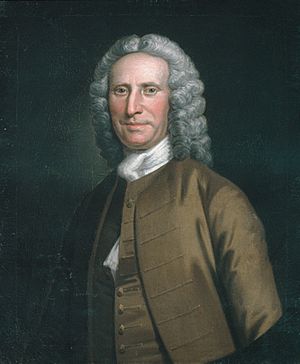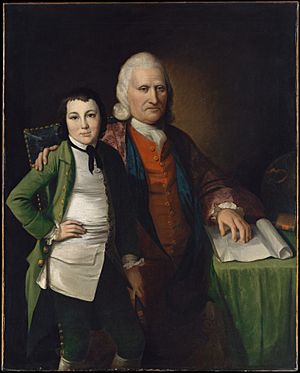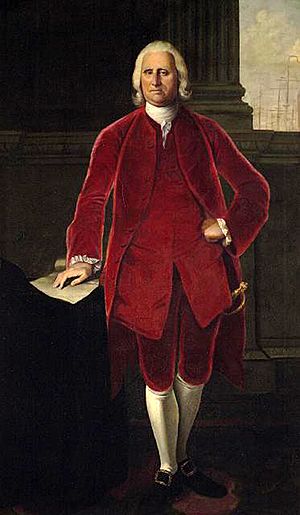Cadwallader Colden facts for kids
Quick facts for kids
Cadwallader Colden
|
|
|---|---|

portrait by John Wollaston
|
|
| Colonial governor of the Province of New York | |
| In office 1760–1762 |
|
| Monarch | George III |
| Preceded by | James DeLancey |
| Succeeded by | Robert Monckton |
| 31ºcolonial governors of Province of New York | |
| In office 1763–1765 |
|
| Monarch | George III |
| Preceded by | Robert Monckton |
| Succeeded by | Sir Henry Moore, 1st Baronet |
| Personal details | |
| Born | 7 February 1688 Ireland |
| Died | 28 September 1776 (aged 88) near Flushing in Queens County on Long Island in New York. |
| Spouse |
Alice Chrystie
(after 1715) |
| Relations | Cadwallader D. Colden (grandson) Stephen De Lancey (grandson) Alice De Lancey Izard (granddaughter) |
| Children | 10, including Alexander, Jane |
| Parents | Alexander Colden Janet Hughes |
| Education | Royal High School |
| Alma mater | Edinburgh University |
Cadwallader Colden (born February 7, 1688 – died September 28, 1776) was an important person in early American history. He was a doctor and a natural scientist. He also served as a lieutenant governor and acting Governor for the Province of New York.
Contents
Early Life and Education
Cadwallader Colden was born on February 7, 1688, in Ireland. His parents were Scottish. His father, Rev. Alexander Colden, wanted him to become a minister. So, Cadwallader went to the Royal High School and Edinburgh University in Scotland.
After graduating in 1705, he decided to study medicine. He learned about anatomy, physics, chemistry, and botany in London. In 1710, he moved to Philadelphia and started his medical practice. He briefly returned to Scotland in 1715 to marry Alice Chryste. They came back to Philadelphia that same year.
In 1717, Governor Robert Hunter invited him to move to New York. By 1720, he became the surveyor general of New York. This meant he was in charge of mapping and measuring land.
Public Service in New York
Colden began his political career in 1720. Governor William Burnett chose him to join the provincial council. He served as lieutenant governor and acting governor several times. These periods included 1760–1761, 1763–1765, 1769–1770, and 1774–1775.
He was acting governor from 1760 to 1762. He was replaced by Robert Monckton in 1762. He served again from 1763 to 1765. Then, from 1769 to 1770, he became acting governor again after Henry Moore died. By this time, Colden was eighty years old. He was later replaced by the Earl of Dunmore.
Colden was also the first colonial representative to the Iroquois Confederacy. This experience led him to write The History of the Five Indian Nations (1727). It was the first book written about this important Native American group.
Challenges as Governor
On November 1, 1765, Colden faced a large protest. A crowd carried a dummy of him in a parade. They were protesting the Stamp Act, a new tax from Britain. Colden was known for defending the King's power strongly. The protesters even took his coach and added it to their parade. At the end, they broke the coach and used it for a big bonfire on Bowling Green.
In 1769, Colden asked the New York General Assembly for money. This money was to help British troops stationed in New York City. The Assembly, led by James Delancey, approved the bill. However, the Livingston family voted against it. They did not want a standing army during peacetime.
By the summer of 1775, British rule in New York was ending. America was entering the Revolutionary era. Colden retired from public life. On September 24, 1776, the British took over New York City. Colden died four days later.
Contributions as a Scientist
Cadwallader Colden was also a dedicated scientist. He made important observations and wrote about them.
Public Health and Disease
In 1743, Colden wrote essays about health in New York City. He noticed that dirty living conditions led to more diseases. This was especially clear during a yellow fever outbreak. Colden's writings were very important. They helped start efforts to improve sanitation in New York City. This was a big step in developing the field of public health.
Correspondence with Benjamin Franklin
In May 1743, Colden started writing letters to Benjamin Franklin. Colden encouraged Franklin to create the American Philosophical Society. Colden was elected a member of this society a year later. Franklin was impressed by Colden's reputation. He wrote back, "I cannot be but fond of engaging in a correspondence so advantageous to me as yours must be."
Scientific Theories
Colden was not afraid to challenge famous scientists. He believed that Isaac Newton had made some mistakes in his theories. Colden spent much of his life trying to correct these supposed errors. In 1751, he published his ideas in London in a book called Principles of Action in Matter.
Botany and Plant Classification
Colden also studied plants near his home in Orange County, New York. He created a way to classify them using Latin names. He sent his work to Carl Linnaeus, a famous Swedish plant scientist. Linnaeus published Colden's work. He even named a group of plants, Coldenia L. Boraginaceae, after him.
Idea for the Erie Canal
In his 1727 book, "History of the Five Nations," Colden suggested a big idea. He thought a canal should be built to connect the Hudson River with the Great Lakes. This would help increase trade with Native Americans for furs. It would also help western settlers transport their farm products. Colden presented this idea to Governor Burnett in 1724.
Personal Life

In November 1715, Cadwallader Colden married Alice Chrystie in Scotland. They had ten children together. Some of their notable children include:
- Alexander Colden (1716–1784)
- Elizabeth Alice Colden (1721–1785), who married Peter DeLancey.
- Cadwallader Colden, Jr. (1722–1797)
- Jane Colden (1724–1766), who was the first female botanist working in America.
Colden owned several enslaved people. They helped with household chores, cooking, taking care of his children, and working in his garden. This was a common practice among wealthy families in that historical period.
He passed away in Spring Hill, near Flushing, New York, on Long Island. He was buried on September 28, 1776, in a private cemetery.
Legacy
Cadwallader Colden is seen as an important figure of the American Enlightenment. He is recognized for his work in botany and public health.
An elementary school in Flushing, New York is named after him. It is known as Public School 214 Queens.
Coldenham, a small town in Montgomery, New York, is also named after him. He was given 3000 acres of land in that area in 1727.


